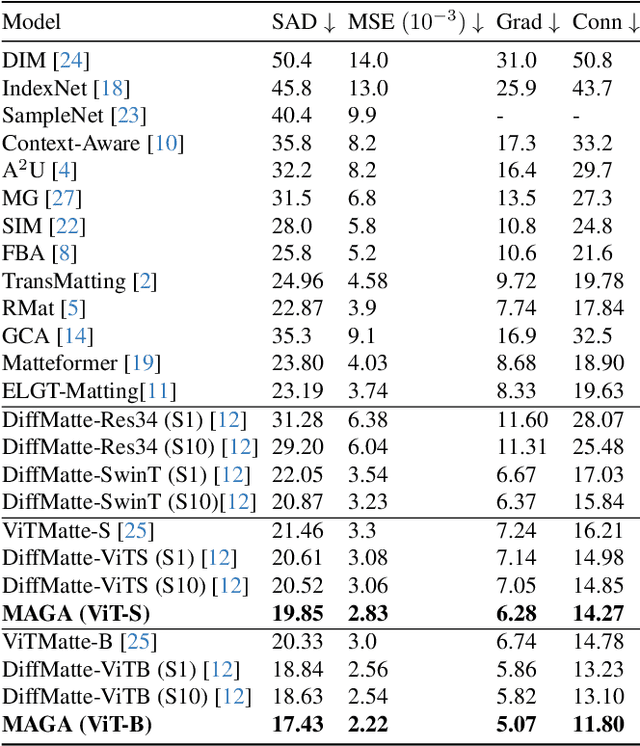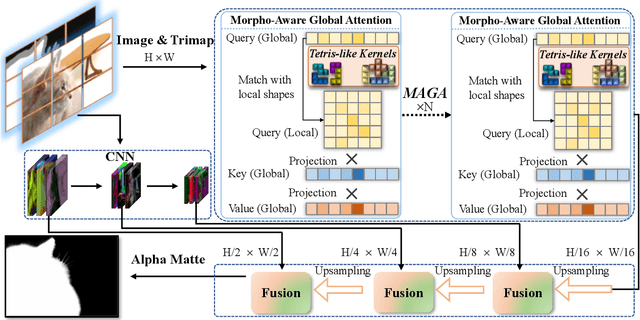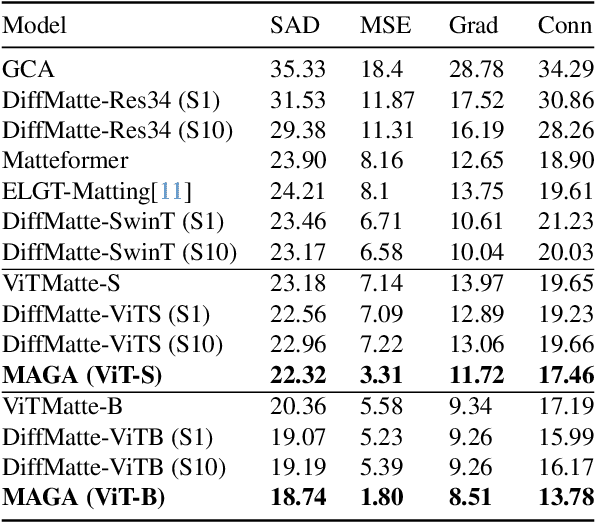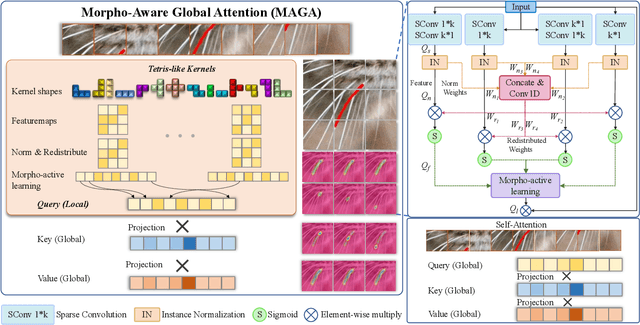Image Matting
Image matting is the process of extracting the foreground object from an image and creating a transparent background.
Papers and Code
Efficient Portrait Matte Creation With Layer Diffusion and Connectivity Priors
Jan 27, 2025Learning effective deep portrait matting models requires training data of both high quality and large quantity. Neither quality nor quantity can be easily met for portrait matting, however. Since the most accurate ground-truth portrait mattes are acquired in front of the green screen, it is almost impossible to harvest a large-scale portrait matting dataset in reality. This work shows that one can leverage text prompts and the recent Layer Diffusion model to generate high-quality portrait foregrounds and extract latent portrait mattes. However, the portrait mattes cannot be readily in use due to significant generation artifacts. Inspired by the connectivity priors observed in portrait images, that is, the border of portrait foregrounds always appears connected, a connectivity-aware approach is introduced to refine portrait mattes. Building on this, a large-scale portrait matting dataset is created, termed LD-Portrait-20K, with $20,051$ portrait foregrounds and high-quality alpha mattes. Extensive experiments demonstrated the value of the LD-Portrait-20K dataset, with models trained on it significantly outperforming those trained on other datasets. In addition, comparisons with the chroma keying algorithm and an ablation study on dataset capacity further confirmed the effectiveness of the proposed matte creation approach. Further, the dataset also contributes to state-of-the-art video portrait matting, implemented by simple video segmentation and a trimap-based image matting model trained on this dataset.
BEN: Using Confidence-Guided Matting for Dichotomous Image Segmentation
Jan 08, 2025Current approaches to dichotomous image segmentation (DIS) treat image matting and object segmentation as fundamentally different tasks. As improvements in image segmentation become increasingly challenging to achieve, combining image matting and grayscale segmentation techniques offers promising new directions for architectural innovation. Inspired by the possibility of aligning these two model tasks, we propose a new architectural approach for DIS called Confidence-Guided Matting (CGM). We created the first CGM model called Background Erase Network (BEN). BEN is comprised of two components: BEN Base for initial segmentation and BEN Refiner for confidence refinement. Our approach achieves substantial improvements over current state-of-the-art methods on the DIS5K validation dataset, demonstrating that matting-based refinement can significantly enhance segmentation quality. This work opens new possibilities for cross-pollination between matting and segmentation techniques in computer vision.
ReFlow6D: Refraction-Guided Transparent Object 6D Pose Estimation via Intermediate Representation Learning
Dec 30, 2024Transparent objects are ubiquitous in daily life, making their perception and robotics manipulation important. However, they present a major challenge due to their distinct refractive and reflective properties when it comes to accurately estimating the 6D pose. To solve this, we present ReFlow6D, a novel method for transparent object 6D pose estimation that harnesses the refractive-intermediate representation. Unlike conventional approaches, our method leverages a feature space impervious to changes in RGB image space and independent of depth information. Drawing inspiration from image matting, we model the deformation of the light path through transparent objects, yielding a unique object-specific intermediate representation guided by light refraction that is independent of the environment in which objects are observed. By integrating these intermediate features into the pose estimation network, we show that ReFlow6D achieves precise 6D pose estimation of transparent objects, using only RGB images as input. Our method further introduces a novel transparent object compositing loss, fostering the generation of superior refractive-intermediate features. Empirical evaluations show that our approach significantly outperforms state-of-the-art methods on TOD and Trans32K-6D datasets. Robot grasping experiments further demonstrate that ReFlow6D's pose estimation accuracy effectively translates to real-world robotics task. The source code is available at: https://github.com/StoicGilgamesh/ReFlow6D and https://github.com/StoicGilgamesh/matting_rendering.
Memory Efficient Matting with Adaptive Token Routing
Dec 17, 2024



Transformer-based models have recently achieved outstanding performance in image matting. However, their application to high-resolution images remains challenging due to the quadratic complexity of global self-attention. To address this issue, we propose MEMatte, a \textbf{m}emory-\textbf{e}fficient \textbf{m}atting framework for processing high-resolution images. MEMatte incorporates a router before each global attention block, directing informative tokens to the global attention while routing other tokens to a Lightweight Token Refinement Module (LTRM). Specifically, the router employs a local-global strategy to predict the routing probability of each token, and the LTRM utilizes efficient modules to simulate global attention. Additionally, we introduce a Batch-constrained Adaptive Token Routing (BATR) mechanism, which allows each router to dynamically route tokens based on image content and the stages of attention block in the network. Furthermore, we construct an ultra high-resolution image matting dataset, UHR-395, comprising 35,500 training images and 1,000 test images, with an average resolution of $4872\times6017$. This dataset is created by compositing 395 different alpha mattes across 11 categories onto various backgrounds, all with high-quality manual annotation. Extensive experiments demonstrate that MEMatte outperforms existing methods on both high-resolution and real-world datasets, significantly reducing memory usage by approximately 88% and latency by 50% on the Composition-1K benchmark. Our code is available at https://github.com/linyiheng123/MEMatte.
On the Compositional Generalization of Multimodal LLMs for Medical Imaging
Dec 28, 2024Multimodal large language models (MLLMs) hold significant potential in the medical field, but their capabilities are often limited by insufficient data in certain medical domains, highlighting the need for understanding what kinds of images can be used by MLLMs for generalization. Current research suggests that multi-task training outperforms single-task as different tasks can benefit each other, but they often overlook the internal relationships within these tasks, providing limited guidance on selecting datasets to enhance specific tasks. To analyze this phenomenon, we attempted to employ compositional generalization (CG)-the ability of models to understand novel combinations by recombining learned elements-as a guiding framework. Since medical images can be precisely defined by Modality, Anatomical area, and Task, naturally providing an environment for exploring CG. Therefore, we assembled 106 medical datasets to create Med-MAT for comprehensive experiments. The experiments confirmed that MLLMs can use CG to understand unseen medical images and identified CG as one of the main drivers of the generalization observed in multi-task training. Additionally, further studies demonstrated that CG effectively supports datasets with limited data and delivers consistent performance across different backbones, highlighting its versatility and broad applicability. Med-MAT is publicly available at https://github.com/FreedomIntelligence/Med-MAT.
ILDiff: Generate Transparent Animated Stickers by Implicit Layout Distillation
Dec 30, 2024High-quality animated stickers usually contain transparent channels, which are often ignored by current video generation models. To generate fine-grained animated transparency channels, existing methods can be roughly divided into video matting algorithms and diffusion-based algorithms. The methods based on video matting have poor performance in dealing with semi-open areas in stickers, while diffusion-based methods are often used to model a single image, which will lead to local flicker when modeling animated stickers. In this paper, we firstly propose an ILDiff method to generate animated transparent channels through implicit layout distillation, which solves the problems of semi-open area collapse and no consideration of temporal information in existing methods. Secondly, we create the Transparent Animated Sticker Dataset (TASD), which contains 0.32M high-quality samples with transparent channel, to provide data support for related fields. Extensive experiments demonstrate that ILDiff can produce finer and smoother transparent channels compared to other methods such as Matting Anything and Layer Diffusion. Our code and dataset will be released at link https://xiaoyuan1996.github.io.
Morpho-Aware Global Attention for Image Matting
Nov 15, 2024



Vision Transformers (ViTs) and Convolutional Neural Networks (CNNs) face inherent challenges in image matting, particularly in preserving fine structural details. ViTs, with their global receptive field enabled by the self-attention mechanism, often lose local details such as hair strands. Conversely, CNNs, constrained by their local receptive field, rely on deeper layers to approximate global context but struggle to retain fine structures at greater depths. To overcome these limitations, we propose a novel Morpho-Aware Global Attention (MAGA) mechanism, designed to effectively capture the morphology of fine structures. MAGA employs Tetris-like convolutional patterns to align the local shapes of fine structures, ensuring optimal local correspondence while maintaining sensitivity to morphological details. The extracted local morphology information is used as query embeddings, which are projected onto global key embeddings to emphasize local details in a broader context. Subsequently, by projecting onto value embeddings, MAGA seamlessly integrates these emphasized morphological details into a unified global structure. This approach enables MAGA to simultaneously focus on local morphology and unify these details into a coherent whole, effectively preserving fine structures. Extensive experiments show that our MAGA-based ViT achieves significant performance gains, outperforming state-of-the-art methods across two benchmarks with average improvements of 4.3% in SAD and 39.5% in MSE.
MAT: Multi-Range Attention Transformer for Efficient Image Super-Resolution
Nov 26, 2024



Recent advances in image super-resolution (SR) have significantly benefited from the incorporation of Transformer architectures. However, conventional techniques aimed at enlarging the self-attention window to capture broader contexts come with inherent drawbacks, especially the significantly increased computational demands. Moreover, the feature perception within a fixed-size window of existing models restricts the effective receptive fields and the intermediate feature diversity. This study demonstrates that a flexible integration of attention across diverse spatial extents can yield significant performance enhancements. In line with this insight, we introduce Multi-Range Attention Transformer (MAT) tailored for SR tasks. MAT leverages the computational advantages inherent in dilation operation, in conjunction with self-attention mechanism, to facilitate both multi-range attention (MA) and sparse multi-range attention (SMA), enabling efficient capture of both regional and sparse global features. Further coupled with local feature extraction, MAT adeptly capture dependencies across various spatial ranges, improving the diversity and efficacy of its feature representations. We also introduce the MSConvStar module, which augments the model's ability for multi-range representation learning. Comprehensive experiments show that our MAT exhibits superior performance to existing state-of-the-art SR models with remarkable efficiency (~3.3 faster than SRFormer-light).
ZIM: Zero-Shot Image Matting for Anything
Nov 01, 2024The recent segmentation foundation model, Segment Anything Model (SAM), exhibits strong zero-shot segmentation capabilities, but it falls short in generating fine-grained precise masks. To address this limitation, we propose a novel zero-shot image matting model, called ZIM, with two key contributions: First, we develop a label converter that transforms segmentation labels into detailed matte labels, constructing the new SA1B-Matte dataset without costly manual annotations. Training SAM with this dataset enables it to generate precise matte masks while maintaining its zero-shot capability. Second, we design the zero-shot matting model equipped with a hierarchical pixel decoder to enhance mask representation, along with a prompt-aware masked attention mechanism to improve performance by enabling the model to focus on regions specified by visual prompts. We evaluate ZIM using the newly introduced MicroMat-3K test set, which contains high-quality micro-level matte labels. Experimental results show that ZIM outperforms existing methods in fine-grained mask generation and zero-shot generalization. Furthermore, we demonstrate the versatility of ZIM in various downstream tasks requiring precise masks, such as image inpainting and 3D NeRF. Our contributions provide a robust foundation for advancing zero-shot matting and its downstream applications across a wide range of computer vision tasks. The code is available at \url{https://github.com/naver-ai/ZIM}.
Towards Natural Image Matting in the Wild via Real-Scenario Prior
Oct 09, 2024



Recent approaches attempt to adapt powerful interactive segmentation models, such as SAM, to interactive matting and fine-tune the models based on synthetic matting datasets. However, models trained on synthetic data fail to generalize to complex and occlusion scenes. We address this challenge by proposing a new matting dataset based on the COCO dataset, namely COCO-Matting. Specifically, the construction of our COCO-Matting includes accessory fusion and mask-to-matte, which selects real-world complex images from COCO and converts semantic segmentation masks to matting labels. The built COCO-Matting comprises an extensive collection of 38,251 human instance-level alpha mattes in complex natural scenarios. Furthermore, existing SAM-based matting methods extract intermediate features and masks from a frozen SAM and only train a lightweight matting decoder by end-to-end matting losses, which do not fully exploit the potential of the pre-trained SAM. Thus, we propose SEMat which revamps the network architecture and training objectives. For network architecture, the proposed feature-aligned transformer learns to extract fine-grained edge and transparency features. The proposed matte-aligned decoder aims to segment matting-specific objects and convert coarse masks into high-precision mattes. For training objectives, the proposed regularization and trimap loss aim to retain the prior from the pre-trained model and push the matting logits extracted from the mask decoder to contain trimap-based semantic information. Extensive experiments across seven diverse datasets demonstrate the superior performance of our method, proving its efficacy in interactive natural image matting. We open-source our code, models, and dataset at https://github.com/XiaRho/SEMat.
 Add to Chrome
Add to Chrome Add to Firefox
Add to Firefox Add to Edge
Add to Edge